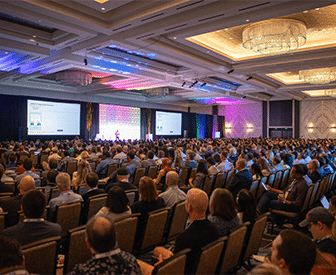The temporary reprieve from credit card late fee limits proposed by the Consumer Financial Protection Bureau hangs on a very thin thread.
The eleventh-hour decision on May 10 by the U.S. District Court for the Northern District of Texas to grant a preliminary injunction and stay of the CFPB’s final rule is only a “pause” and not a conclusive finding in the case.
We’ll unpack the ruling and then dig into the broader debate and the potential implications of the rule, both for institutions explicitly covered and those that are not — officially.

Banking Transformed Podcast with Jim Marous
Listen to the brightest minds in the banking and business world and get ready to embrace change, take risks and disrupt yourself and your organization.

Why Industry Cloud for Banking?
PwC’s Industry Cloud for Banking helps deliver personalized products and services that today’s customers expect.
District Court’s Reasoning Hangs on a Decision Currently Before U.S. Supreme Court
U.S. District Court Judge Mark Pittman issued his decision late on Friday, May 10, a deadline that had been imposed by the Fifth Circuit Court of Appeals. Most of the 12-page decision airs Judge Pittman’s feelings about the higher court dictating how he should handle the matter administratively.
Nonetheless, Pittman granted the preliminary injunction and an indefinite stay of the rule. He specifically based his decision on an earlier appellate decision by the Fifth Circuit Court of Appeals in CFSA v. CFPB.
The gist of that case was that CFPB’s payday lending rule could not go into effect because, as the Fifth Circuit ruled, the CFPB’s funding, set out under the Dodd-Frank Act of 2010, is unconstitutional. The CFPB is not subject to the congressional appropriations process, instead drawing its funds from the budget of the Federal Reserve, which is itself an independent agency not subject to the congressional process. It was this funding scheme that the Fifth Circuit ruled unconstitutional — and hence struck down the payday lending regulation.
The CFPB however has appealed that earlier case to the U.S. Supreme Court. The high court heard oral arguments in the case in October 2023. A decision is imminent and many experts believe the Supreme Court will reverse the Fifth Circuit’s decision, according to veteran banking attorney Alan Kaplinsky, senior counsel of Ballard Spahr’s Consumer Financial Services Group.
Such a ruling would knock out the main reason for approval of the preliminary injunction — although Judge Pittman did write in passing that the plaintiffs “make compelling arguments” under the laws they cited, including the CARD Act, the Truth in Lending Act and the Administrative Procedures Act.
In an extended comment on LinkedIn, Kaplinsky said he believes that if the Supreme Court decides the earlier case in CFPB’s favor, then “I would expect the District Court to decide whether any or all of the alternative grounds for invalidating the late fee rules are sound.”
Read more: Credit Cards Fuel Big Banks’ Loan Growth Amid ‘Normalization’
How We Got Here, What’s Been Going On, and What’s Been Brewing All Along
Since the Credit Card Accountability Responsibility and Disclosure Act of 2009, the Federal Reserve has been required to issue rules on late charges. When the CFPB came into being under the Dodd-Frank Act, the new bureau inherited many Fed rules and responsibilities, including card regulation.
In its March rule, the bureau imposed a new ceiling of $8 per late payment. Institutions could, under the new rule, charge more, but only if they can demonstrate that their actual costs exceed $8.
Whatever the courts decide, experts suggest that the rule may mostly accelerates changes to credit card pricing that were already underway.
“CFPB is the tailwind that will make some of what was already happening happen more quickly,” says Biota Li Macdonald, director of marketing strategy at Comperemedia, a Mintel company.
Read more: Should Banks Beware Credit Score ‘Grade Inflation’?

How the Debate Over Card Pricing Continues in the Wake of CFPB’s Rule
In the wake of the rule’s promulgation, most card issuers stayed silent about their response, including strategies to make up lost revenue, according to Emily Rueth, managing director and founder at Vicuse Payments Advisors LLC.
But a few institutions signaled their plans.
Synchrony, for example, had begun implementing changes last December in anticipation of the bureau’s rule, including charging certain customers for receiving paper account statements and raising some rates. Even with that lead time, CEO Brian Doubles told analysts at an April earnings briefing that “it will be extremely challenging to get [the new rule] implemented in May.”
At Capital One, after testing the waters with an $8 fee late last year, the company implemented the change widely, while applying an increased charge for cash advances on many cards, according to a post on LinkedIn by Andrew Davidson, senior vice president and chief insights officer at Comperemedia.
Elsewhere, says Kaplinsky, the large banks he has discussed this with have been assuming a worse-case scenario and they intend to be in compliance with the regulation by the original deadline.
Rueth says organizations she’s been in touch with have been looking at multiple options, notably rates and minimum payments. The first means simply raising the annual percentage rates on credit card accounts to recapture lost revenue lost The second would require changing the calculation for minimum card payments. Right now, she explains, many issuers require a minimum payment of 1.5%-2%. She says some have been looking at hiking that percentage to 3%.
Such moves “will cause an increase in the cost of credit for all consumers who revolve,” says Rueth. She also believes some consumers will be shut out from card credit over time because issuers won’t consider them a good risk without the option of charging significant late fees.
Read more: Gen Z Credit Card Use is Outpacing Millennials’, Amid Financial Stress and Ballooning Debt

Industry Cloud for Banking from PwC
See how PwC's Industry Cloud for Banking can help solve everyday business challenges.

Creating A Community with CQRC’s Branch Redesign
Find out how SLD helped CQRC Bank to create the perfect harmony of financial services, local culture, and the human touch in their branch transformation.
Read More about Creating A Community with CQRC’s Branch Redesign
CFPB’s Rule May Influence Cardholder Behavior
Payments consultant Richard Crone has been tracking card pricing issues for years. He says his research indicates that 60% of consumers revolve, maintaining an outstanding balance on their credit cards. These cardholders account for most late payments on cards and 80% of the fees charged are incurred by “repeat offenders.”
Crone believes that CFPB’s move to slash late fees to $8 would significantly reduce the deterrent effect of late fees and remove a guard rail that he thinks these consumers need.
As it is, Crone calculates that the average late fee of $36 comes to only a 32.7 basis point fee on the average household balance of $11,000 — a comparative bargain for getting extra time. (His $36 figure is higher than CFPB’s $32 due to differences in the base for computing the average.) Crone thinks the $8 level in the bureau’s rule is so cheap that it could be abused.
He also says that the types of changes issuers have been looking at to address lost late-fee revenue would fall on “the 80% of consumers who pay on time. It’s just not fair.”
Significantly, this potential shift of the burden formerly addressed with late fees would hit the 80% at a time when U.S. credit card outstandings have passed $1 trillion, setting new records.
Crone believes that the banking industry should have pursued a publicity campaign stressing implications of the CFPB rule to build support for amendment or reversal. (Sen. Tim Scott, ranking Republican member of the Senate Banking Committee, has introduced a bill that would kill the regulation via the Congressional Review Act, though in a Democratic Senate that’s likely a long shot.)
Read more: Will Banks and Fintechs Become Retail Media Networks?

Market Reality: CFPB’s Policy Isn’t As Narrow as It’s Written
Officially CFPB’s rule would apply only to larger issuers, defined as those with at least 1 million open cardholder accounts. This accounts for the top 35 credit card issuers in the U.S. There are roughly 3,900 bank and credit union issuers, which at first glance would make it seem many will not be covered.
Rueth suggests that this distinction is illusory. She says consumers are smart and know how to use internet tools to shop around. She doubts that many for whom late-fee levels are important will choose cards that carry higher fees. As a result, all issuers will likely have to behave as if they are covered by the rule.
“Regardless of their size, all issuers are going to have a delicate balancing act,” says Rueth.
Publishing Tomorrow: Is It Finally Time to Reinvent Credit Card Fees?







